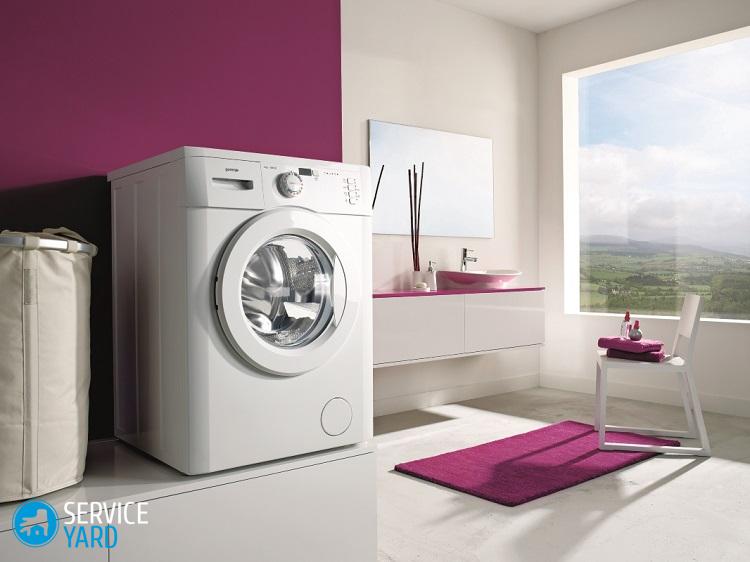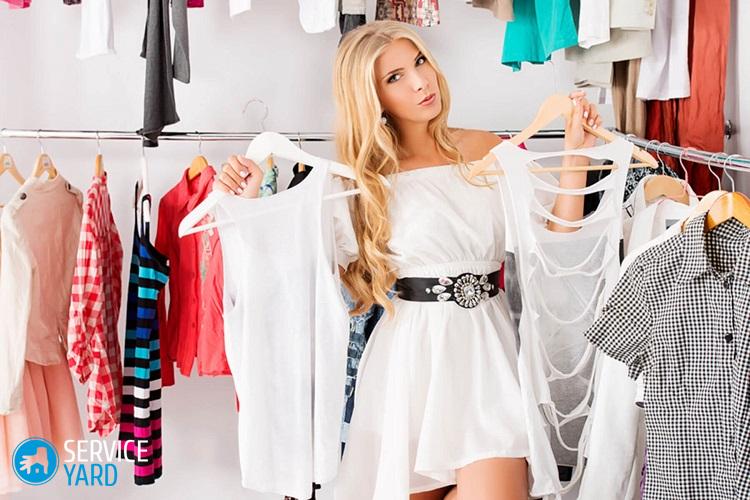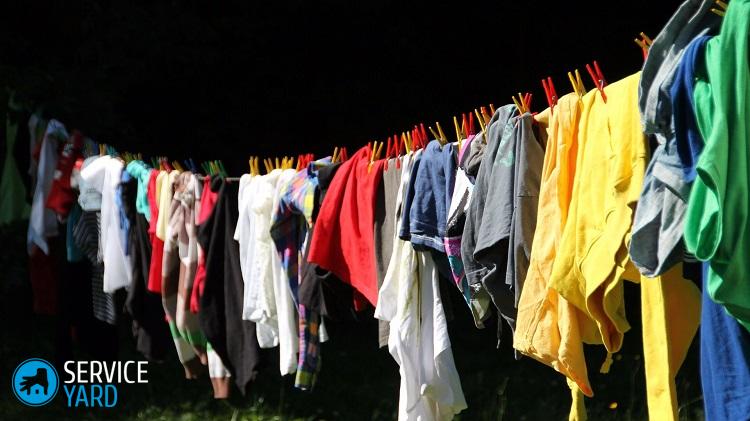How to care for clothes correctly?

Oddly enough, the wear of textiles does not come from careless socks, but from careful but inept care. Interaction with soap, washing liquids and powders, exposure to high temperatures - all this leads to the fact that the clothes either tear or lose their attractive appearance. Proper washing, ironing and storage will significantly extend the life of things. Let's try to figure out how to care for clothes correctly.
to contents ↑Storage secrets
Sometimes you have to watch how good and relatively new things become completely unfit for wear. Ugly “bubbles” form on the knees of trousers, sweaters, jackets and shirts catastrophically lose their shape. This can be avoided if things are stored properly.
Hangers
It is convenient to store on them jackets, blouses, shirts - so products keep their shape longer. Pants are stored folded and thrown over the crossbar, blouses and shirts - on hangers with special clothespins.
Important! You should not hang one product on another: they wrinkle and become untidy in appearance.
The shoulders must also be selected correctly so that they match the width of the shoulders. Otherwise, the appearance of “bubbles” cannot be avoided.
Cardigans and sweaters
It is desirable to store these products when folded. On the hanger, heavy cashmere and wool items are stretched, so their place is on the shelf. Jeans are also stored folded.
Get rid of the spools
The spools make the most fashionable and stylish product sloppy and untidy. It's not about whether you are neat or not. The reason for their formation is a synthetic admixture in the composition of the yarn. Therefore, we can say that the appearance of pellets is a natural process. But this is not a reason to leave them on clothes.
A special battery-powered machine helps to get rid of this trouble. Just a few minutes, and your cardigan or sweater again looks like brand new. The pellets are assembled in a special removable tank that is easy to clean.
Cleaning roller
A sticky video, of course, will not save you from spools, but your pet’s hair, dust and small specks will collect perfectly.
Covers
They are relevant for the proper seasonal storage of things, as well as for clothes made from expensive fabrics such as silk or velvet. Solid covers perfectly protect against dirt, moisture and dust.
Transparent boxes
This is not a matter of care, but rather of convenience. You can not only keep things in order, but also easily navigate in the closet. Now you do not have to search for the right pair for a long time.
Makeup - Last
To remove traces of makeup from clothes is quite difficult. Therefore, you must first get dressed, and then apply makeup. The exception is things with buttons or “zippers”. They are put on after they have made up. So you can not stain clothes with makeup.
“No” to unnecessary things
Clothes that you do not wear do not need to be stored. It’s much more rational to hand it over or take it to a charity. There will be more space in the closet, and it will become much easier to navigate in the vacant space.
to contents ↑How to take care of things? Wash
It turns out that it’s not enough to understand the badges with the care rules printed on the labels. Washing is a serious test for clothes. The fiber is exposed to heat, detergents and bleaches. It is not surprising that clothes deteriorate from constant washes. Here are a few secrets to help keep your clothes longer.
Wash only dirty
Washing clothes just to refresh them should not be. It is best to use a steamer - floor or manual. Frequent washing leads to rapid wear of the product, and superheated steam, gently acting on the fibers, straightens the product. At the same time, the clothes look like freshly washed.
The advantage of the steamer is the ease of use and speed of putting things in order. Of course, a hand-held device will not cope with bedding or jeans, but it will perfectly refresh laces, appliques and small details. Steam is ideal for delicate fabrics, curtains and curtains.
How to prepare for washing?
Remember to check your pockets. Otherwise - you run the risk of losing the thing and disable the washing machine:
- Wash clothes with zippers fastened, but buttons unbuttoned.
- To keep things coloring, turn them around.
- Do not be too lazy to sort the laundry. Moreover, not only on the principle of “white-dark”. Wash delicate clothing separately from coarse items.
- Wash heavily and slightly soiled items separately.
Temperature mode
If the washing temperature is indicated on the label, say 60 degrees, it is not necessary to follow this blindly. The higher the water temperature, the faster the fiber wears out. There are no exceptions. Therefore, if a thing is slightly contaminated, then it must be washed at a lower temperature. In addition, modern powders remove stains well at low temperatures.
Important! The temperature for washing shedding fabrics is 30 degrees.
Special bags
They are used to wash underwear, tights, swimwear, socks. This makes it possible not to wash these products by hand. At the same time, the appearance of the products will be fully preserved.
When washing bras, do not forget to fasten them so as not to damage the lace trim with hooks. For delicate things, choose the appropriate mode. The maximum speed is 600.
How to choose a detergent?
- Handwash powder is not suitable for automatic machine. Due to strong foaming, the clothes hardly move and remain contaminated.
- Universal detergents are suitable for all types of fabrics. However, specialized compounds (for wool, linen, delicate fabrics) do their job better. Such products retain color and shape well. It is advisable to have detergents for white and colored fabrics.
- It is advisable to wash clothes made of microfiber, membrane fabric, lace and delicate textiles with mild liquid products.
- A tablespoon of vinegar added to the liquid detergent drawer helps prevent shrinkage and molting.
- Stains from blood, ice cream, sauces are well washed with powders with enzymes. However, the maximum washing temperature when using such a tool is 50 degrees.
Important! Do not use too much detergent. You are unlikely to achieve an additional effect, and ugly white stains will remain on the fabric. Detergent residue on seams and fabrics can trigger an allergic reaction.
How to get rid of stains?
The easiest way to remove stains - special stain-removing compositions. Before using the stain remover, test it in an inconspicuous area:
- A cloth stained with blood should be soaked in cold water before washing.
- Ethanol or vodka removes ink well. After this treatment, the residues are well washed with a machine.
- Sprinkle wine stains with salt before washing.
- Stains from grease, lipstick or varnish before washing, it is advisable to treat with medical alcohol.
- Pollution from the earth is washed off with the addition of vinegar.
Rules for the care of white clothing:
- Wash the white items after putting them on 2-3 times. This is especially true for T-shirts and shirts.
- Wash white clothing separately from colored clothing.
- Do not abuse the bleaching compound. It has a damaging effect on textile fibers. The working resource of the thing is reduced.A much more gentle whitening method is the use of baking soda added to washing powder. The temperature regime is 60 degrees.
Denim
The main disadvantage of a jeans is its shedding properties. Soak the new jeans for half a day in water with sodium chloride, after turning them inside out. The fabric retains color well after numerous washes, but:
- Before jeans wash out jeans.
- Use mild detergents.
- The temperature regime is 30-40 degrees.
- Often jeans do not need to be washed.
- Dry your trousers upside down or horizontally.
Ironing Rules
Ironing is a very time-consuming task that takes a lot of time. However, it should not be abandoned. The ironed thing looks prettier and neater. To simplify the process, use a good iron with a constant supply of steam, as well as water spray and steam boost. The self-cleaning function will not be superfluous. It will help to avoid white streaks on the surface. Consider the rules for ironing different types of fabrics.
Label information
The label with the badges on it is a kind of guide for the care of clothes. Therefore, you need to know what the information means:
- Strikethrough image of the iron - the product cannot be ironed and steamed.
- Strikethrough image of the iron with two lines from the bottom - the thing can not be steamed, but you can iron.
- An iron with a different number of points inside is the maximum allowable temperature for ironing. 1 point corresponds to 100 degrees, 2 to 200 degrees.
Iron the dampened cloth
First of all, because it is difficult to smooth out a dry product in a high-quality manner. It’s much easier to iron slightly moistened textiles or use the steam function. An exception to this rule is viscose things that are ironed dry.
Temperature mode
The peculiarity of the iron is that it heats up quickly and cools much more slowly. Therefore, it is advisable to iron products according to the principle “from low to high temperature” - start with acrylic, silk and polyester and finish with cotton and linen.
Rules for ironing different types of fabrics:
- Synthetics should be washed with a warm iron using moistened gauze.
- To iron the silk, it is better to use a manual steamer. Using an iron, moisten the fabric and set the temperature to low. It is not necessary to spray the surface, otherwise, spots will remain.
- Things from long-nap fabrics - velor, soft drape, camel hair, ironed from the inside out with steam.
- Knitwear can be ironed at high temperature, but not too tightly pressing the sole of the iron. Such clothes are very stretched.
- Flax is ironed moistened, at a temperature of 180-220 degrees and with a steam supply function.
Stock footage
Use these useful tips, and your clothes will remain brand new and elegant for a long time.
- How to choose a vacuum cleaner taking into account the characteristics of the house and coatings?
- What to look for when choosing a water delivery
- How to quickly create comfort at home - tips for housewives
- How to choose the perfect TV - useful tips
- What to look for when choosing blinds
- What should be running shoes?
- What useful things can you buy in a hardware store
- Iphone 11 pro max review
- Than iPhone is better than Android smartphones
























